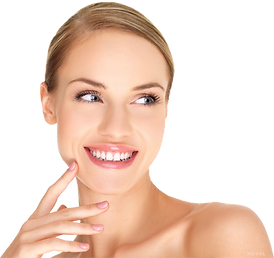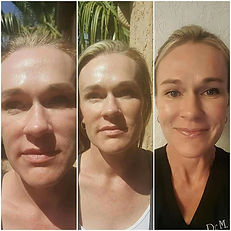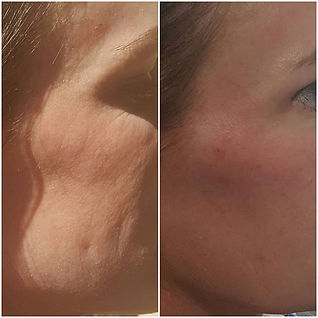Frequently Asked Questions
Botox versus Dermal Fillers: What’s the Difference?
Both Botox and Dermal Fillers are used to treat signs of aging but are used to tackle very specific (and different) problems.
Botox paralyzes/relaxes a muscle, while Fillers FILL (add volume) a hollow space.
Botox might be used for those angry 11’s (the lines in between the eyebrows) or for crow’s feet or forehead wrinkles, whereas Fillers might be used to fill in smile lines (those parentheses) or to add volume to lips or cheeks.
Botox is used in areas where wrinkles occur when the face is making an expression, such as squinting or scowling. Fillers are used in areas where wrinkles and hollows are visible even when the face is relaxed.
What is BOTOX, XEOMIN and DYSPORT? (a 4th is in clinical trials)
Botox is the common trade name, but they are botulinum toxins used to relax a muscle to decrease the appearance of wrinkles.
This is a good option for:
-
Smoothing the forehead
-
Angry 11’s
-
Lifting the brows
-
Smoothing crow’s feet and bunny lines (horizontal lines and the ridge of the nose)
-
Gummy smiles
-
Eye twitching
-
Soften vertical lip lines or adding a “lip pop”
-
Lift and upturn the corners of the mouth (DAO’s)
-
Platysmal bands (smoothing the neck)
-
Hyperhidrosis (excessive sweating)
-
Dimpling or creases in the chin
Botox and Xeomin typically start working in 7 to 10 days and last approximately 3-5 months
Dysport typically starts working in 3-4 days and lasts approximately 3-5 months.
How much does it cost?
Botox is most expensive, followed by Xeomin, followed by Dysport.
-
Botox $10 - $16/unit
-
Xeomin $8 - $14/unit
-
Dysport $4 - $9/unit
Botox and Xeomin require twice as many units per treatment area, but costs approximately 1.5 x more than Dysport.

WHAT IS A CHEMICAL PEEL?
A chemical peel is a technique used to improve the appearance of skin. A chemical solution of varying strengths and chemicals is applied to the skin to make it blister and peel. There are superficial, medium depth, and deep depth peels available.
What do they do?
Chemical peels penetrate deep into the skin dissolving desmosomes, oils and softening keratinocytes. Chemical peels are a good option for:
-
Photodamage (sun damage)
-
Acne scars
-
Large pores
-
Overly Oily skin causing acne
-
Crepey skin under the eyes or dark circles
-
Fine lines and wrinkles
-
If you aim to Lighten/Brighten the skin
-
Blackheads
How many syringes will I need?
If you have never had a filler treatment before and are wanting a full facial correction, then a good rule of thumb is 1 syringe per decade of life (A 40 year old may be satisfied with 1 syringe, and may need as many as 4 for full facial correction.)
Another good option is to start low and go slow. The nice thing about dermal fillers is that it works like scaffolding. You can fill cheeks with 1 or 2 syringes, wait 2-4 weeks (hyaluronic acid continues to attract water for up to 2 weeks) and decide if you want to add more
How much does it cost?
Cost is based on the number of syringes. 1 syringe can range from $400 to $800. Most Hyaluronic Acid Fillers (Juvederm, Restylane, Volbella) start at $425. Voluma and Sculptra are the most expensive. Prices vary. Follow us on social for up to date pricing and specials.
WHAT ARE DERMAL FILLERS?
Products like Juvederm, Restylane, Voluma, Volbella, Sculptra, Radiesse (there are too many to mention) are used to FILL or add volume to hollow areas. This is a good option for:
-
Hollowing under eyes/tear troughs (there are numerous things to consider for this treatment and Dr. Pettitt will discuss the risks, benefits and alternative treatments)
-
Lifting and contouring the cheeks
-
Loss of the malar fat pads under the eye
-
Reshaping the nose
-
Volumizing the smile lines (nasolabial folds, parentheses)
-
Hollowing temples
-
Volumizing the jowls!!
-
Sculpting the chin
-
Enhancing, shaping, volumizing the LIPS
-
Softening vertical lip lines (smokers lines, straw lines)
-
And filling in odd dents and hollows
-
Filling in the hands
There are many dermal fillers to choose from and Dr. Pettitt will help you to narrow down your choices. Fillers with a hyaluronic base can be reversed if you decide you hate it.
Fillers that are calcium based must be surgically removed and will show up on X-Rays. The various dermal fillers will last anywhere from 6 months to 2 years (some last even longer!)

Left: Before
Middle: Immediately after
Right: 15 days after
1 syringe per cheek
How many syringes will I need?
If you have never had a filler treatment before and are wanting a full facial correction, then a good rule of thumb is 1 syringe per decade of life (A 40 year old may be satisfied with 1 syringe, and may need as many as 4 for full facial correction.)
Another good option is to start low and go slow. The nice thing about dermal fillers is that it works like scaffolding. You can fill cheeks with 1 or 2 syringes, wait 2-4 weeks (hyaluronic acid continues to attract water for up to 2 weeks) and decide if you want to add more
How much does it cost?
Cost is based on the number of syringes. 1 syringe can range from $425 to $800. Most Hyaluronic Acid Fillers (Juvederm, Restylane, Volbella) start at $425. Voluma and Sculptra are the most expensive. Prices vary.
WHAT IS MICRONEEDLING?
Microneedling, also called collagen induction therapy (CIT), is a minimally invasive skin rejuvenation treatment that utilizes a dermal pen containing tiny needles used to create channels at a controlled depth beneath the skin. The microtrauma caused, stimulates new collagen and elastin formation. The channels allow for a direct pathway to deliver hyaluronic acid, antioxidants such as Vitamin C (which promotes collagen) and Vitamin A (which promotes cell turnover), and PRP. This treatment is voted as Best of and hottest skincare trend ALMOST EVERY YEAR. This is amongst our clients’ favorite treatment, with or without PRP. Microneedling is great for the following conditions:
-
Fine lines and wrinkles
-
Pigment problems including melasma, hyperpigmentation, sun spots, vitiligo
-
Thickened skin
-
Acne and chicken pox scars
-
Keloids
-
Delivering physician grade skin care and antioxidants
-
Large pores
-
Stretch marks
-
Crepey skin
-
Dull skin
-
Premature aging skin
-
Rosacea
-
Hair Loss
-
Sun damaged skin
How many treatments will I need?
The epidermis consists of dead cells that are constantly flaking or washing off, which are then replaced by new cells. This skin cell cycle depends on age as well as hormones, nutrition, sun exposure, illness, stress and other environmental factors. In general, in our 30’s, that cycle is about 28 days, but in our 40’s and 50’s, that cell turnover cycle slows to 30 to 60 days (and longer). Therefore, when PRP is used aesthetically, treatments should be spaced at least 4 weeks apart.
Typically, 3 – 4 treatments are necessary to achieve optimal results.
How long does it last?
When optimal results are achieved, it is recommended that a maintenance treatment is done every 6 to 12 months. If you would like to extend those amazing results, Keep reading…
How much does it cost?
Microneedling treatments with Hyaluronic acid are $270 (look for specials on social media)

WHAT IS PRP?
Quite possibly the best thing currently available for skin regeneration. At our office, we call it the magic sauce. PRP or Platelet rich plasma contains hundreds of proteins called growth factors that have the capability to stimulate collagen and elastin, two primary components of the body’s connective tissue which comprises 80% of the dermis. Collagen gives your skin strength, whereas Elastin enables your skin to stretch and bounce back. PRP contains many pluripotent cells. The term “pluripotent” means “many potentials”. These virgin cells are master cells and they’re able to produce any cell or tissue the body needs to repair itself. PRP was originally used in the 70’s in heart surgeries, and gained popularity in the 90’s in orthopedics, repairing ligaments, tendons and arthritis.
How is it used in aesthetics?
PRP is collected by drawing blood out of the patient’s arm and spinning it in a centrifuge to separate the platelet rich portion of plasma from red blood cells and the platelet poor portion. The PRP is then either injected into the skin using small needles, cannulas, or a micropen. When used with the micropen, it has been termed “The VAMPIRE FACIAL”; When used with dermal fillers, it is called the “VAMPIRE FACELIFT”. The growth factors, pluripotent cells and cytokines initiate a cascade of healing mechanisms that treat the following aesthetic and dermatologic conditions:
-
EVERYTHING
-
Melasma and hyperpigmentation
-
Large pores
-
Acne scars
-
Any scars
-
Resurfacing
-
Lightening/Brightening
-
Fine lines and wrinkles
-
Skin tightening
-
Thinning hair
-
Stretch marks
-
Vitiligo
-
Liposcleroderma
-
Keloids
-
Tissue healing post plastic or jaw surgery
-
Thick skin and hyperkeratosis
-
Sun damage
-
O-shots and P-Shots
-
Filling in hollows and can be used WITH dermal fillers
-
Chicken skin (Keratosis pilaris)
-
Soooooo much more***
Where can I use PRP?
Scalp, face, lips, cheeks, mouth (dentistry), neck, chest, arms, hands (anywhere you have skin), joint spaces, muscles, tendons, organs
How many treatments will I need & How often?
The epidermis consists of dead cells that are constantly flaking or washing off, which are then replaced by new cells. This skin cell cycle depends on age as well as hormones, nutrition, sun exposure, illness, stress and other environmental factors. In general, in our 30’s, that cycle is about 28 days, but in our 40’s and 50’s, that cell turnover cycle slows to 30 to 60 days (and longer). Therefore, when PRP is used aesthetically, treatments should be spaced at least 4 weeks apart.
Typically, 3 – 4 treatments are necessary to achieve optimal results.
How long does it last?
Whichever treatment you decide on will require maintenance and PRP is no different. It is estimated that the effects of PRP last anywhere from 9 months to 2 years (the above lifestyle variables must be considered)
How much does it cost?
The cost of PRP varies by the concentration of PRP (the kit needed to extract cells: 1-2x concentration vs. 8-10 x concentration), as well as the area being treated. Micropen facial treatments using PRP start at $350 for 1 - 2 x concentration and $550 for 8 - 10x concentration

Dr. Pettitt's untouched photo
after 1st PRP treatment
WHAT IS KYBELLA?
Kybella is a nonsurgical injection technique used to treat submental fullness….aka DOUBLE CHINS.
Kybella (deoxycholic acid) is the only FDA approved injectable that permanently destroys fat cells as well as aids in the absorption of fat. Kybella is an alternate to liposuction requiring less down time.
How many treatments will I need and how long will it last?
Each treatment takes about 15 to 20 minutes. Most people require 2 – 3 treatments. Kybella permanently destroys fat cells, therefore, once you reach your desired aesthetic goal, no further treatment is needed.

Dr. Pettitt's results 7 weeks
after 2 vials of Kybella
Are there any side effects?
The most common side effects are swelling, pain, numbness, redness, and areas of hardness in the treatment area. Most patients complain of a “bullfrog”, full feeling for 1-3 weeks. I can personally attest to this. The majority of the swelling is during the 1st 48 hours...but I definitely wanted to crawl in a hole for those 48 hours. Plan accordingly.
How much does it cost?
Treatments range from $800 to $1,200 and results are permanent




